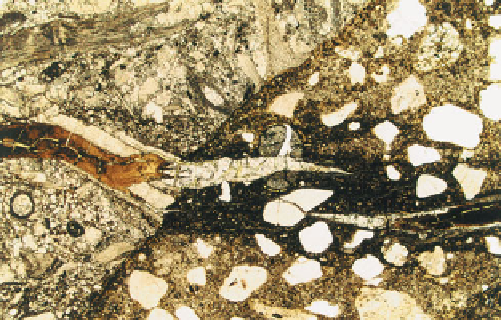Geoscience Reference
In-Depth Information
224
Limestone and other carbonate rocks are commonly
used as concrete aggregates. Three different AARs have
been observed in carbonate rock aggregates:
1. ACR of dolomitic limestones that results in
dedolomitization.
2. ACR of nondolomitic limestones that produces
reaction rims.
3. ASR of various carbonate rocks containing reactive
silica.
ACR is a rare and poorly understood form of AAR. The
mechanism is thought to be different from ASR, though
the associated concrete deterioration is often similar.
Researchers have struggled to explain the mechanism of
ACR expansion but most hypotheses centre on the
possible role of dedolomitization. It is thought that alkali
solutions react with the mineral dolomite (in the
aggregate) to form brucite and calcite as follows:
CaMg(CO
3
)
2
225
+ 2NaOH
→
Mg(OH)
2
+ CaCO
3
+ Na
2
CO
3
Dolomite
Alkali
Brucite
Calcite
While there is no doubt that the dedolomitization
reaction does occur in concrete with carbonate aggregate,
whether it is responsible for deleterious expansion has
not been established. In many cases of apparent ACR, it
has been shown that expansion has in fact been caused
by ASR involving cryptocrystalline silica within
carbonate aggregates. The microscopical textures
associated with ACR and dedolomitization are illustrated
in Katayama (2003). Figures
224
and
225
show an
example of ASR within concrete with limestone coarse
aggregate, where the silica for the reaction was provided
by siliceous bands (chert) within the limestone.
Diagnosing the cause(s) of deterioration in concrete is
complicated by the common coexistence of evidence for
several different mechanisms. For example, coexistence
of the following combinations of concrete deterioration
mechanisms has been reported in case studies by Sims
et
al
. (2004):
• ASR and leaching.
• ASR and frost attack.
• ASR (dominant) and DEF.
• DEF (dominant) and ASR.
• TSA (dominant) and ASR.
• Acid attack, reinforcement corrosion, and ASR.
224, 225
Concrete with ASR from siliceous limestone
coarse aggregate (upper left) seen in PPT (
224
) and
XPT (
225
). A fine crack originates in the coarse
aggregate particle and runs through the surrounding
cement matrix. The crack is filled with alkali-silica
gel. The cement matrix adjacent to the gel-filled crack
appears portlandite depleted in XPT; ×35.
226
226
Concrete with both DEF and ASR. Tuff coarse
aggregate particle (lower left) exhibits both gel-filled
internal cracks indicative of ASR and an ettringite-
filled peripheral parting indicative of DEF. Cracks
running through the cement matrix are mainly filled
with ettringite. The cement matrix is shown dark
brown; PPT, ×35.
Figure
226
shows pile cap concrete from a bridge pier
suffering from map cracking. In thin section, evidence
for both DEF and ASR was apparent. In this case, DEF
appeared to be dominant as a high abundance of
ettringite-filled partings and cracks suggested that much
more expansion was associated with DEF than ASR.




